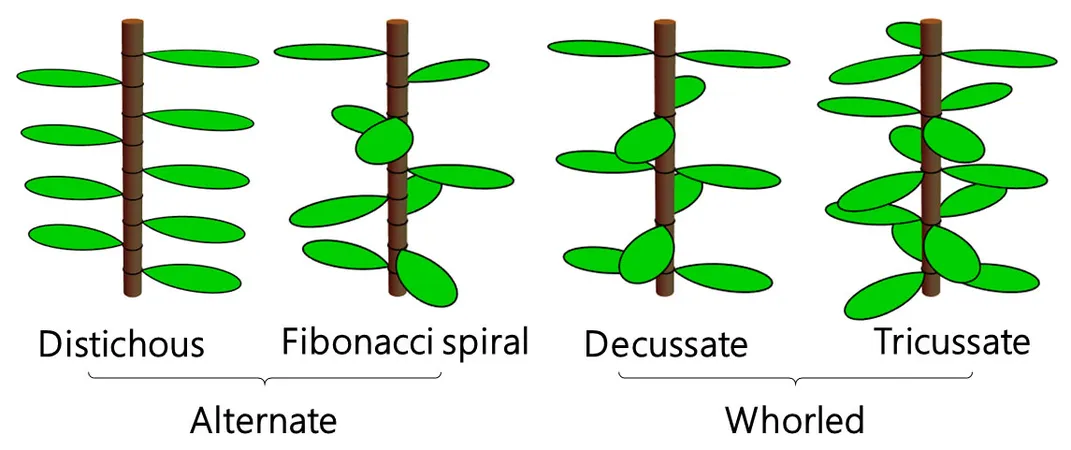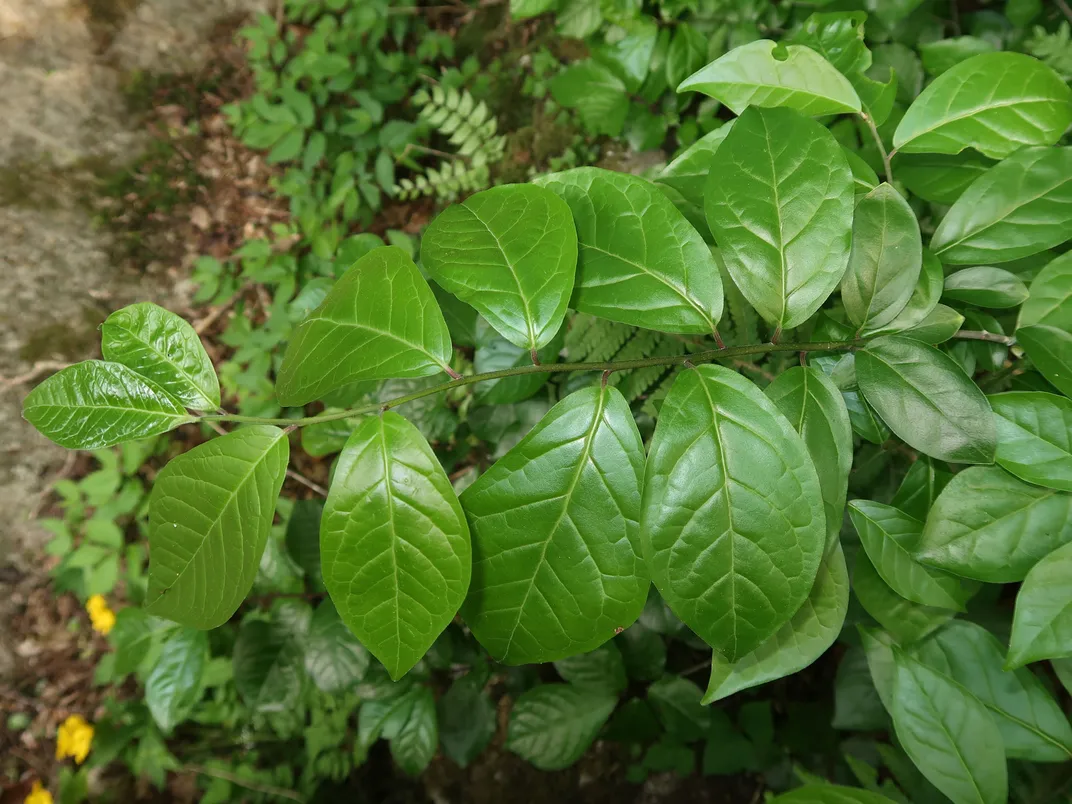Decoding the Mathematical Secrets of Plants’ Stunning Leaf Patterns
A Japanese shrub’s unique foliage arrangement leads botanists to rethink plant growth models
/https://tf-cmsv2-smithsonianmag-media.s3.amazonaws.com/filer/ad/5a/ad5aea4e-1c44-4cce-87e4-860740b67860/aloe_polyphylla_1.jpg)
To the untrained eye, plants may appear to grow rather impulsively, popping out leaves at random to create one big green jumble. Take a closer look, though, and you’ll find that a few curiously regular patterns pop up all over the natural world, from the balanced symmetry of bamboo shoots to the mesmerizing spirals of succulents.
In fact, these patterns are consistent enough that cold, hard math can predict organic growth fairly well. One assumption that has been central to the study of phyllotaxis, or leaf patterns, is that leaves protect their personal space. Based on the idea that already existing leaves have an inhibitory influence on new ones, giving off a signal to prevent others from growing nearby, scientists have created models that can successfully recreate many of nature’s common designs. The ever-fascinating Fibonacci sequence, for example, shows up in everything from sunflower seed arrangements to nautilus shells to pine cones. The current consensus is that the movements of the growth hormone auxin and the proteins that transport it throughout a plant are responsible for such patterns.

However, certain leaf arrangements continue to stump popular models for plant growth, including the Douady and Couder equations (known as DC1 and DC2) that have dominated since the 1990s. A team led by University of Tokyo researchers studying a shrub known as Orixa japonica found that earlier equations couldn’t recreate the plant’s unusual structure, so they decided to rethink the model itself. Their updated model, described in a new study in PLOS Computational Biology, not only reproduces the once-elusive pattern, but it also may describe other, more common arrangements better than previous equations, authors say.
“In most plants, phyllotactic patterns have symmetry—spiral symmetry or radial symmetry,” says University of Tokyo plant physiologist Munetaka Sugiyama, senior author of the new study. “But in this special plant, Orixa japonica, the phyllotactic pattern is not symmetric, which is very interesting. More than 10 years ago, an idea came to me that some changes in the inhibitory power of each leaf primordium may explain this peculiar pattern.”
Botanists use the divergence angles, or angles between consecutive leaves, to define a plant’s phyllotaxis. While most leaf arrangement patterns keep a constant divergence angle, the O. japonica shrub, which is native to Japan and other parts of East Asia, grows leaves in an alternating series of four repeating angles: 180 degrees, 90 degrees, 180 degrees again, then 270 degrees.

This pattern, which the researchers dubbed “orixate” phyllotaxis, is not just a onetime anomaly, as plants from other taxa (like the “red-hot poker” flower Kniphofia uvaria, or the crepe myrtle Lagerstroemia indica) alternate their leaves in the same complicated sequence. Because the leaf arrangement pops up in different spots on the evolutionary tree, authors concluded the similarity came from a common mechanism that warranted further study.
After testing the Douady and Couder equations with different parameters, the authors could produce patterns that were close to the alternating orixate arrangement, but none of the simulated plants matched perfectly with the O. japonica samples they dissected and studied. So the team built a new model by adding another variable to the Douady and Couder equations: leaf age. Former models assumed leaves’ inhibitory power stayed the same over time, but this constant was “not natural from the viewpoint of biology,” Sugiyama says. Instead, Sugiyama’s team allowed for the possibility that the strength of these “keep-away” signals changed over time.
The resulting models—which the team refers to as expanded Douady and Couder models, EDC1 and EDC2—succeeded in recreating, through computerized growth, the intricate leaf arrangements of O. japonica. Beyond this feat, the expanded equations also produced all the other common foliage patterns and predicted the natural frequencies of these varieties more accurately than previous models. Especially in the case of spiral-patterned plants, the new EDC2 model predicted the “super-dominance” of the Fibonacci spiral as compared to other arrangements, while previous models failed to explain why this particular shape seems to appear everywhere in nature.
“Our model, EDC2, can generate orixate patterns in addition to all major types of phyllotaxis. This is clearly an advantage over the previous model,” Sugiyama says. “EDC2 also fits better to the natural occurrence of various patterns.”
/https://tf-cmsv2-smithsonianmag-media.s3.amazonaws.com/filer/8a/5a/8a5afa53-b4f6-43af-99b1-7ae643d44923/202182.jpg)
The authors can’t yet conclude what exactly causes leaf age to affect these growth patterns, although Sugiyama speculates that it may have to do with changes to the auxin transport system over the course of a plant’s development.
Such mysteries could be solved by the “push and pull” between computational models and lab experiments, says Ciera Martinez, a computational biologist who was not involved in the study. The authors’ model provides an exciting step toward a better understanding of phyllotaxis and leaves room for other botanists to fill in the gaps with plant dissection and analysis.
“With models, even though we might not know the exact mechanism yet, we are at least given powerful clues on what to look for,” Martinez says in an email. “Now we just have to look closer at the molecular mechanisms in real plants to try and discover what the model predicts.”
/https://tf-cmsv2-smithsonianmag-media.s3.amazonaws.com/filer/7d/2f/7d2ffcf1-1db0-4b21-933b-08a8a8b34d1e/edc2orixate_video_by_takaaki_yonekura_cc-by.gif)
Sugiyama’s team is working to refine their model even further and get it to generate all known phyllotactic patterns. One “mysterious” leaf pattern, a spiral with a tiny divergence angle, still evades computational prediction, although Sugiyama thinks they’re close to cracking the leafy code.
“We don’t think our study is practically useful for society,” Sugiyama says. “But we hope that it will contribute to our understanding of the symmetric beauty in nature.”
/https://tf-cmsv2-smithsonianmag-media.s3.amazonaws.com/accounts/headshot/Maddie_3.jpg)
/https://tf-cmsv2-smithsonianmag-media.s3.amazonaws.com/accounts/headshot/Maddie_3.jpg)